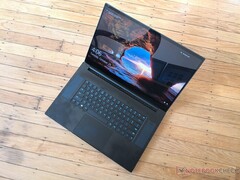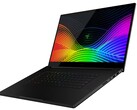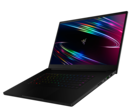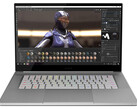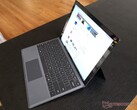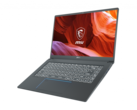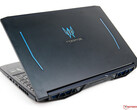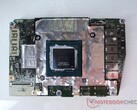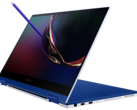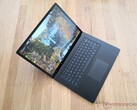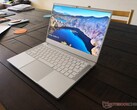Gaming laptops with 4K UHD displays aren't new. One of the first 17.3-inch gaming laptops equipped with a native 4K UHD display was the EVGA SC17 released back in 2016. While this may have sounded great on paper back in the day, the panel suffered from one major issue: extremely slow response times.
Black-to-white and gray-to-gray response times on the aforementioned 17.3-inch EVGA laptop were as long as 26 ms and 22.8 ms, respectively, compared to just 4.4 ms or 5.6 ms on the latest 15.6-inch fast refresh rate panels designed specifically for gaming. Ghosting was abhorrently noticeable on the EVGA to even the untrained eye which made the laptop a poor choice for fast-paced games. If you wanted a 17.3-inch 4K UHD laptop with the same fast refresh rates and response times as the newest 15.6-inch 1080p MSI GS65 or Razer Blade 15, then you would have been out of luck - until now.
The Razer Blade Pro 17 was recently announced to ship with a new 4K UHD IPS panel that promises fast response times, a 120 Hz native refresh rate, and full AdobeRGB coverage - three attributes that were previously impossible to find together on a 17.3-inch 4K display. We had the chance to test out this particular Blade Pro 17 SKU and have discovered that it utilizes an AU Optronics B173ZAN03.3 IPS panel - a first in our database. Our measurements below confirm that it is able offer significantly faster response times than any other 17.3-inch 4K UHD IPS panel before it while feeling twice as smooth as any 17.3-inch 4K UHD IPS due to its higher 120 Hz native refresh rate. Perhaps more impressively, it is able to achieve this while maintaining the traditionally wide gamut and high contrast ratios of 4K UHD IGZO panels. 4K UHD OLED laptop panels have yet to become available in 17.3-inch screen sizes and reaching a stable 120 FPS is not necessary to take advantage of a 120 Hz panel.
There are a few drawbacks to the new AU Optronics panel to keep in mind. For example, it still trails recent 15.6-inch 60 Hz 4K UHD OLED panels in both contrast ratio and response times despite the faster refresh rate. Furthermore, 50 percent gray to 80 percent gray response times could still be faster when compared to the AU Optronics B173HAN04.0 panel as found on the Blade Pro 17 FHD SKU. Price is also a huge boundary at $3700 USD for the Blade Pro 17 equipped with the 4K UHD 120 Hz display.
If you want this particular 17.3-inch 4K UHD 120 Hz panel, then you'd have to get the Razer Blade Pro 17 as of this writing. We fully expect other 17.3-inch laptops to offer this same panel as an option in the near future.
| Razer Blade Pro 17 4K UHD 120 Hz AU Optronics B173ZAN03.3, IPS, 17.3", 3840x2160 | Razer Blade Pro 17 RTX 2060 AU Optronics B173HAN04.0, IPS, 17.3", 1920x1080 | Dell XPS 15 7590 9980HK GTX 1650 Samsung 156WR04, SDCA029, OLED, 15.6", 3840x2160 | Gigabyte Aero 17 XA RP77 AU Optronics B173ZAN03.2, IPS, 17.3", 3840x2160 | MSI P65 Creator 9SF-657 AU Optronics AUO41EB, IPS, 15.6", 3840x2160 | MSI GS65 Stealth 9SG Sharp LQ156M1JW03 (SHP14C5), IPS, 15.6", 1920x1080 | EVGA SC17 GTX 1070 Sharp LQ173D1JW31, IPS, 17.3", 3840x2160 | |
|---|---|---|---|---|---|---|---|
| Display | |||||||
| Display P3 Coverage | 84.8 | 61.1 | 88.1 | 86.8 | 84.4 | 67.6 | 87.3 |
| sRGB Coverage | 99.9 | 89.4 | 99.6 | 100 | 100 | 97.5 | 100 |
| AdobeRGB 1998 Coverage | 98.6 | 62.5 | 91.8 | 99.5 | 98.5 | 68.9 | 98.8 |
| Response Times | |||||||
| Response Time Grey 50% / Grey 80% * | 15.2 ? | 6.8 ? | 2.3 ? | 45.6 ? | 51 ? | 13.6 ? | 45.6 ? |
| Response Time Black / White * | 10.4 ? | 8.8 ? | 2.4 ? | 30.4 ? | 31 ? | 12 ? | 35.2 ? |
| PWM Frequency | 59.5 ? | 23260 ? | 1042 ? | ||||
| Screen | |||||||
| Brightness middle | 346.7 | 300.4 | 421.2 | 667.3 | 445 | 282.3 | 399.1 |
| Brightness | 332 | 289 | 417 | 633 | 462 | 269 | 360 |
| Brightness Distribution | 91 | 93 | 94 | 90 | 83 | 90 | 81 |
| Black Level * | 0.27 | 0.32 | 0.46 | 0.5 | 0.32 | 0.4 | |
| Contrast | 1284 | 939 | 1451 | 890 | 882 | 998 | |
| Colorchecker dE 2000 * | 5.62 | 2.32 | 6.06 | 3.53 | 4.75 | 1.17 | 4.78 |
| Colorchecker dE 2000 max. * | 9.36 | 3.81 | 11.89 | 6.88 | 7.79 | 3.29 | 7.65 |
| Colorchecker dE 2000 calibrated * | 3.81 | 2.95 | 3.79 | 1.06 | |||
| Greyscale dE 2000 * | 5.5 | 1.5 | 2.8 | 0.9 | 4.49 | 1.3 | 3.8 |
| Gamma | 2.25 98% | 2.3 96% | 2.15 102% | 2.17 101% | 2.49 88% | 2.2 100% | 2.03 108% |
| CCT | 6175 105% | 6764 96% | 6235 104% | 6533 99% | 7374 88% | 6643 98% | 7288 89% |
| Color Space (Percent of AdobeRGB 1998) | 87.2 | 57.4 | 81 | 87.1 | 87 | 63.8 | 86.9 |
| Color Space (Percent of sRGB) | 100 | 89 | 99.6 | 100 | 100 | 97.5 | 100 |
| Total Average (Program / Settings) |
* ... smaller is better




